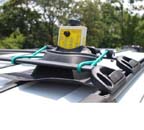 From a US Geological Survey press release:
From a US Geological Survey press release:
Recording bats’ echolocation “calls” is the most efficient and least intrusive way of identifying different species of bats in a given area, providing insight into some populations that have been decimated by white-nose syndrome.This new research by scientists from Virginia Tech, the U.S. Geological Survey and the U.S. Army is published in the Journal of Ecology and the Natural Environment.
White-nose syndrome, an unprecedented disease of cave hibernating bats caused by a cold-loving fungus, has caused the deaths of more than six million bats. It has spread from central New York to at least 22 states and five Canadian provinces since 2006. In addition to the endangered Indiana bat, populations of the formerly abundant little brown bat and northern long-eared bat have experienced severe disease-related declines, particularly in the Northeast and central Appalachians.
“Acoustic sampling is a noninvasive sampling technique for bats, and its use often allows for the detection of a greater number of bat species in less time than traditional sampling methods such as netting,” said study co-author W. Mark Ford, a USGS scientist at the Virginia Cooperative Fish and Wildlife Research Unit at Virginia Tech. “Low population numbers make netting both time and cost prohibitive. Netting also has low capture rates for WNS affected species. Moreover, acoustic sampling minimizes the handling of bats, which lessens the chance of unintended cross-contamination and exposure to the white-nose fungus from one bat to another or from equipment and personnel to uninfected bats.”
Read the rest of the USGS press release here.
Read the paper (open access;PDF) here.
Photo: An acoustic bat detector in a roof-top car mount. Courtesy New York State Department of Environmental Conservation and the bat survey coalition
